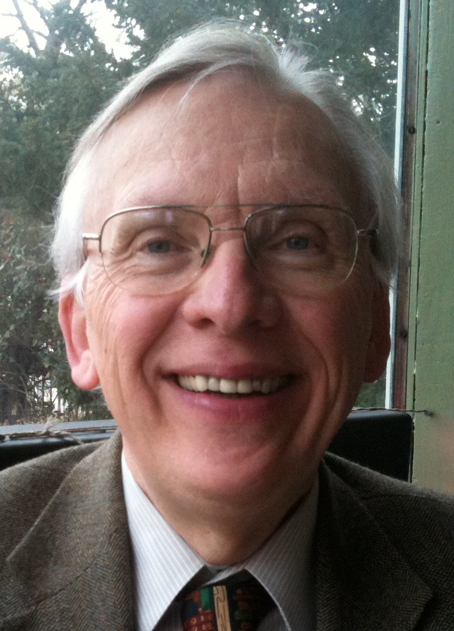Is Gravity the Whole Story?
Alternative Cosmologies, Part III
I began a very ambitious project about five years ago: to write a book that integrated scientific and spiritual views of the universe into a fact-based, rational whole. I’m still plugging away, slowly, and this series of interviews on alternative cosmologies is part of my research on the cosmological section of my book-in-progress, Cosmic Ecology.

I met Tim Eastman virtually, through a mutual friend, at the time I began my book project. Eastman is a PhD plasma physicist, a consultant, and a Wyle Deputy Group Manager for science support at the National Aeronautics and Space Administration’s (NASA’s) Goddard Space Flight Center.
Eastman has more than 30 years of experience in research and consulting in space physics, space science data systems, space weather, plasma applications, public outreach and education, and philosophy. He has provided key leadership for the nation’s research programs in space plasma physics, while program manager at NASA Headquarters and the National Science Foundation. He has published over 100 research papers in space physics and related fields.
We met when our mutual friend recommended me to review some chapters of a book Tim was working on. Since then, I’ve had numerous exchanges with Tim about my own book project and related questions. Tim advised me, after reviewing some early chapters of my book, on relativity theory and cosmology, to look into the role of plasmas from the stellar to the cosmic scale. With repetition of this point from Tim, I eventually did so.
During the course of my research, Erik Lerner’s book The Big Bang Never Happened made a big impression on me. It presented a strong case that much of today’s work in cosmology is highly biased toward Big Bang cosmology (BBC) because this has become the prevailing view, and any contrary views are received with great skepticism. Evidence or speculation contrary to the BBC is routinely ignored or misrepresented. I highly recommend Lerner’s book.
Lerner’s preferred alternative to the BBC is known generally as “plasma cosmology,” and is a subset of the less controversial field of “plasma astrophysics.” Plasmas are by far the most common naturally-occurring state of normal (non-dark) matter in the universe – stars are made of it, galaxies are made of it, and likely most everything in between. Plasmas are electromagnetically active and these forces are, according to Lerner and others, highly important at both the astrophysical and cosmological scale. Plasma cosmology was developed originally by Hannes Alfven, a Swedish Nobel Prize-winning physicist known for his work on plasmas and magnetohydrodynamics (MHD). Lerner and many others have also contributed to this approach.
This is the third installment in a series on alternative cosmologies and, at this time, I find plasma cosmology’s key concept pretty compelling – that electromagnetic forces produced by large-scale plasmas throughout the universe can play an important role in cosmology. I also find very valuable its emphasis on facts and experiment, extrapolated from laboratory experiments to astrophysical systems, and upward to cosmological-scale observations. A key conclusion of most formulations of plasma cosmology – and the key reason it is considered controversial – is that, as Lerner’s book title makes plain, plasma cosmology asserts that the Big Bang never happened. Rather, the universe probably had no beginning. It just is — but it is also in constant flux.
Unfortunately, plasma cosmology can’t get no respect among many cosmologists today. In a previous interview, Bob Kirshner of Harvard, part of the team whose work led to the 2011 Nobel Prize in physics, responded to my question “Do you think there’s any merit to plasma cosmology?” with one word: “No.”
There is, however, growing recognition, as Tim describes below, of the role of plasmas in at least some aspects of cosmology. And the field of plasma astrophysics is well-established.
There has been some debate between BBCers and plasma cosmology proponents, but all too often claims and theories contrary to BBC simply go unanswered. In the spirit of debate and good science more generally, I was honored to interview Eastman via email about plasma astrophysics and the subset of this field often described as plasma cosmology.

How did you come to work in plasma cosmology?
My field of study is plasma physics and space plasmas, in particular. Plasmas are an interactive mix of charged particles, neutrals and fields that exhibits collective effects. Further, plasmas carry electrical currents and generate magnetic fields. Plasmas constitute more than 99% of visible matter in the universe because most stars are plasma entities (see plasmas.org, Eastman’s Web site covering all aspects of plasma science and applications, including space plasmas and plasma astrophysics).
Researchers working in cosmology generally do not reference their particular research program (whether Big Bang, quasi-steady state, or other) as part of defining their research discipline, nor should they. In this sense, there are very few researchers who self-designate as “plasma” cosmologists. Ideally, scientifically-grounded astrophysicists who focus on the sub-field of cosmology should seek evidence-based explanations, especially through ever-improved models and analysis to better interpret available observations, augmented with testing of alternative hypotheses.
In the past decade, there have been substantial advances in applying electromagnetism (EM) and plasma concepts, including advances in MHD, to many astrophysical systems. For example, the Topical Group in Plasma Astrophysics of the American Physical Society (APS), formed in 1998, provides one forum among others for scientists focused on applying EM and plasma science to astrophysical systems.
The growing importance of this sub-field has been increasingly recognized in recent years, for example in a 2004 report from the National Academy of Sciences (NAS).1 Within the past couple of decades, there has been a substantial rise in the number of peer-reviewed research papers and major monographs focused on plasma astrophysics. Nearly 5 million hits result from a current Google search on “plasma astrophysics.”
What are the key concepts in plasma astrophysics/cosmology?
Plasma astrophysics attempts to build on established results in space plasma physics (primarily in the solar system context) realized over the past half century. This experience has demonstrated multiple processes and scales for which both gravity and EM/plasmas are dynamically important. In contrast, standard cosmology considers only gravity to have a role at the cosmological scale.
Researchers in plasma astrophysics build systematically on the combination of laboratory experiments, observations, modeling, and theory to evaluate applications of EM/plasma science to astrophysical systems.2 Further, plasma astrophysicists generally apply a bottom-up methodology which, as in Dr. Goedbloed’s works, goes from the laboratory, to nearby space plasma tests, to local astrophysical systems, and then progressively to more distant astrophysical systems. This approach contrasts with the top-down methodology most often applied in “standard” cosmology, which begins with a speculative deductive framework from which various consequences are checked against observations (usually with a focus on “confirmation”). In other words, inductive approaches to plasma cosmology systematically adapt well-established lab-tested facts, and nearby space-based tests, to larger and larger astrophysical systems.
What are the key empirical facts in favor of plasma cosmology?
Key empirical results that support plasma astrophysics, including applications to cosmology, include the following, among many others:
Both gravity and EM/plasmas have become well established as dynamically important for several key plasma processes and at multiple scales throughout the solar system. Studies of these systems are part of contemporary space physics (aka “Heliophysics”), which comprises a major division of NASA science programs.
Both gravity and EM/plasmas are increasingly recognized as dynamically important in a broad range of astrophysical systems; e.g., neutron star accretion disks; galactic radio jets, active galactic nuclei, shock fronts, magnetic reconnection, and stellar magnetospheres (see peer-reviewed research of the community of researchers in plasma astrophysics; APS Topical Group and others).
Recent observations indicate the presence and importance of plasmas at all redshifts (z) and all scale lengths (e.g., observations of plasmas at both low and high redshift, both for interstellar and intergalactic plasmas; hot halos around high-z protogalaxies, strong X-ray galaxy clusters, etc.).
Without substantial shielding, electromagnetic forces are far stronger than weak gravitational forces (indeed, stronger by 10 to the 39th power!); fortunately, this large imbalance is mostly shielded out by the rapid movement of charges that assures quick responses to maintain a condition very close to charge neutrality (most space plasmas are thus “quasi-neutral”). However, such “Debye shielding” is rarely absolute. Indeed, as stated by Goedbloed and Poedts (2004):
“By definition, plasmas are an interactive mix of charged particles, neutrals, and fields that exhibits collective effects. In plasmas, charged particles are subject to long-range, collective Coulomb interactions with many distant encounters. Although the electrostatic force drops with distance (~1/r2), the combined effect of all charged particles might not decay because the interacting volume increases as r3. Magnetic field effects are often global with their connections reaching to galactic scales and beyond.”
Thus, space plasmas will carry currents and generate magnetic fields at stellar scales (as with our own heliosphere), galactic scales and beyond.
When the standard Big Bang model was first hypothesized and formulated (1920s through early 1950s), a common assumption was that the intervening space between stars, and especially between galaxies, is empty. However, beginning in the 1950s, the field of space plasma physics was created in conjunction with new discoveries that space is not empty (viz. Van Allen’s discovery of the radiation belts and numerous other results over the next half century); indeed, the current understanding among researchers in space plasma physics and plasma astrophysics (and others) is that nowhere in the universe is space truly empty (plasmas, including their neutral component, and fields permeate all space environments and all scales); of course, in most such domains, except within and near stars, the plasma density is very low (at the same time, the associated scale lengths are very large).
Very promising, yet preliminary modeling of galactic evolution using relatively simple MHD models has been carried out by Dr. Anthony Peratt of Los Alamos National Laboratory, yielding galactic formations roughly equivalent to observed configurations. These results are comparable to the best gravity-only model results, which require far more adjustments in the simulations, including ad hoc inclusions of dark matter and dark energy components [as discussed in the first two installments of this series of interviews]. Instead of limiting models to these two extreme cases, sophisticated models incorporating both gravity and EM/plasma processes need to be carried out – such work may lead to results that no longer require some of the ad hoc strategies currently used.
Standard cosmology at present is based on the assumption that redshifts (z) are created exclusively by “cosmic expansion” and Doppler redshifts. However, recent research has revealed a number of physically viable non-expansion redshift mechanisms, some of which can be directly tested in the laboratory.3 Some effort toward testing such frequency transfer processes is emerging but has been discouraged under the [circular] assumption that redshift is necessarily due to cosmic expansion.
Substantial evidence has emerged in recent decades leading many researchers to seriously question the standard Big Bang cosmology, including its most recent version, the Lambda-CDM model. Recently I examined the literature on this question and compared results, pro and con. My conclusion was basically inconclusive, and summarized in the invited paper Cosmic Agnosticism, Revisited (Journal of Cosmology, Vol. 4, 655-663, 2010).
For those committed to the standard Big Bang research program, the facile dismissal of any dynamically important role for EM/plasmas characterizes a core commitment to the standard program, but this commitment can undermine good scientific methodology. In cosmology, we need greater attention to evidence-based research that actively seeks testing between alternative hypotheses versus just gathering more “confirmation” instances; efforts are needed that are more evidence-based and less theory-driven.
Your responses sound very reasonable and will prompt most lay readers to ask the obvious question: if the facts are so supportive of a strong role for EM/plasmas having an important role in cosmology why is plasma astrophysics/cosmology dismissed so readily by the large majority of physicists as an alternative to the Big Bang cosmology?
Once again, let me return to my response to your first question concerning “plasma cosmology.” As I explained there, plasma astrophysics is a well-established, mainstream component of modern astrophysics. Already such research has revealed how both gravity and EM/plasmas are very important for astrophysical systems at stellar and galactic scale, and beyond. It’s an ongoing research program as to how these results can be extended to basic cosmology questions. In that sense, as with many other colleagues who work in space plasma physics and plasma astrophysics, I wish to remain open about cosmology issues; i.e., please don’t put me in any “box” about these issues, even the “plasma” box. In my “Cosmic Agnosticism”, I show that leading experts continue to disagree on fundamental cosmology questions, which to me indicates that we should be generous in the consideration of alternative hypotheses (well represented by your first two installments about “Alternative Cosmologies”) and skeptical about claims to final knowledge.
More generally, with respect to the philosophy of science are you a Kuhnian? In other words, do you agree with Kuhn that even sciences as purportedly hard-nosed as physics don’t operate strictly on a facts-and-observation-based model, but, instead, as much on the basis of entrenched interests, funding, politics and plain old ego?
Kuhn’s historical approach has demonstrated the importance of such non-scientific factors. However, as with most scientists, I apply an evidence-based critical realism that recognizes the overall “progress” of scientific knowledge.
With regard to methodology and trying to maintain open scientific dialogue, I’m uneasy about your framing of the questions. Although useful for some pedagogical purposes, such presumed dichotomies are too easily plugged into the standard narrative. For example, Steady State vs. Big Bang was the classic debate in earlier decades, presumably “settled” in favor of the latter. However, with their quasi-steady-state model, that result is seriously questioned in later works by Narlikar, Hoyle, Arp and others (see your Alternative Cosmologies, Part II). Standard accounts often feature the earlier debate, but rarely discuss comparisons with the latter model. Another example is the seemingly neutral “Plasma Cosmology” write-up in Wikipedia, which highlights Alfven’s limited and flawed model and barely mentions results within the past decade. This obvious straw man leads the average reader to affirm the standard model. (Note: I have been informed that several efforts to update this flawed write-up have been consistently blocked).
I understand that you advocate a cosmological “agnosticism” at this time, but it does seem that you agree with much of what plasma cosmology suggests about large-scale dynamics. If plasma cosmology were a superior approach to understanding the large-scale dynamics of our universe, what would be the best ways, in your view, to achieve the necessary paradigm shift away from strict adherence to the Big Bang Cosmology?
In my view, the very best research today, relevant to these questions, is being carried out by a diverse community of researchers pursuing data-driven space plasma and observational astrophysics research. Such mainstream research has achieved many excellent advances in the past few decades, and promises to indefinitely continue such scientific “progress.” To the extent that related theoretical work fails to consider, as appropriate, both gravity and EM/plasmas in astrophysical processes, such work, in my view, is simply not relevant to the real world.
Does the recent data supporting the existence of the Higgs boson have any impact on plasma physics?
For this question, I refer the reader to the answer provided by Professor Cahill (see Alternative Cosmologies, Part I).
Does Plasma Cosmology support the notion of an eternal universe, with no beginning? If so, where did the matter and energy in the universe come from?
In the past few decades, research in complex systems, from space plasmas to biology and ecology, has demonstrated the emergence (indeed, “creation”) of new structures and coupled entities at multiple levels (micro-, meso-, macro-). Such creativity in the cosmos is pervasive. However, there are many unresolved difficulties in applying such a “creation” concept to the cosmos itself (as done in Big Bang theory). Finally, I’m inclined to avoid the word “eternal” and simply suggest that the age of the universe is indefinite. For an excellent book on this question, I recommend Hilton Ratclliffe The Static Universe (Montreal: Apeiron, 2010).
What books or other resources would you recommend to readers interested in exploring the pros and cons of various cosmological theories themselves?
Google search terms: plasma physics, space plasmas, plasma astrophysics. (Caution: “plasmacosmology.net” and related links are not sufficiently cautious about shielding effects, in contrast to standard accounts, which often presume that electromagnetism is completely shielded out except at very small scale (in conflict with the quote above from Goedbloed and Poedts (2004) – the real world strikes a balance between these two extremes.) Indeed, it’s appropriate to think of our universe as a “plasma universe,” as first coined by Tony Peratt.
Some books I recommend are:
Plasma Science: Basic Physics of the Local Cosmos, National Academy Press, Washington, D.C. 2004
Heliophysics: Plasma physics of the Local Cosmos, C. Schrijver and Siscoe, eds., Cambridge, 2009.
Walfgang Kundt, Astrophysics: A New Approach, Springer-Verlag, 2005.
Goedbloed and Poedts, Principles of Magnetohydrodynamics: With Applications to Laboratory and Astrophysical Plasmas, Cambridge, 2004.
Anthony Peratt, Plasma Cosmology: Evolution of the Plasma Universe, Springer Press, 2013 (in press); update to Physics of the Plasma Universe, Springer, 1992.
And some websites:
References via Wikipedia entries “Plasma physics” and “Astrophysical plasma”
Perspectives on Plasmas (links, references)
Space Plasma Sites:
Are you optimistic that cosmology will evolve in the next decade or two to take EM/plasmas more seriously?
From what I’ve seen lately, EM/plasmas are already being taken seriously in certain areas of mainstream astrophysics (e.g., from basic understanding of solar and stellar plasma outflows to applying MHD models to interstellar and intergalactic “gas” (i.e., plasma) flows), and many astrophysicists maintain a careful distance from cosmological speculations.
Similar to the evolution of ideas over the past century, the “mainstream” view will continue to evolve, and some changes affecting cosmology issues will likely come from unexpected quarters. For example, as reflected in the current debate about quantum gravity models [quantum gravity theories attempt to meld quantum mechanics and gravity, which are currently incompatible, into a single theory], it’s widely recognized that physics lacks a unified theory encompassing both quantum physics and relativity, and for many the weak link in that combination is general relativity (which unlike quantum physics lacks experimental testing on the relevant scales).
In unifying these theories, any presumed metric likely needs to be transformed into a dynamical entity characterized solely by solutions of the relevant equations. It remains an open question how best to address this problem. Some researchers are taking a new look at emergent gravity approaches of which one example is that proposed by Reginald Cahill in his “Process Physics.” By mid-century, I predict that the current focus on the Big Bang hypothesis, and related fashions such as string theory and multiverses, will steadily decline as new discoveries will force their exponents to adopt even more ad hoc hypotheses.
The methodology and results of well-tested, mainstream observational astrophysics will gradually expand and shine new light on domains now dominated by untested speculation. Eventually a new paradigm will emerge, participants will gradually cease converting coefficients of highly abstract models into the latest grand speculation (e.g., dark energy), and cosmology will finally become a mature science. At that stage, the best of prior work, including quasi-steady-state, plasma astrophysics, and others, will be gradually integrated because of their effectiveness in providing enhanced predictive success and understanding.
Finally, what is the ultimate fate of the universe if both plasmas and gravity are relevant on the cosmological scale?
To date, the only comprehensive models that have been carried out are based on gravity-only assumptions usually within the context of the Big Bang paradigm (with ad hoc coefficients added for consistency; viz. dark matter and dark energy). As yet, no one has attempted the much more complex task of formulating a cosmic-scale model based on both gravity and EM/plasmas, a task possibly beyond capabilities of the current generation of supercomputers. Following Hilton Ratcliffe and many other astrophysicists who question the cosmic expansion hypothesis, I imagine that the universe on a sufficiently large spatial scale is relatively constant in structure over a sufficiently long time scale, thus perhaps exemplifying the “perfect cosmological principle” (i.e., at sufficiently large scales, no substantial differences in either space, time, or their combination). Nevertheless, significant differences as observed would be expected on more limited space and time scales. For me this is much more satisfactory than treating as pure “coincidence” that the time since the Big Bang (a contingency of nature) just happens “now” to be nearly identical to the inverse Hubble time (based on a presumed “constant” of nature). To me such coincidences are strong indicators that a new and deeper understanding is needed.
1 E.g., “Plasma Physics of the Local Cosmos” (NAS, Space Studies Board, 2004).
2 E.g., see the two major monographs on MHD, with “applications to laboratory and astrophysical plasmas,” by Hans Goedbloed; also the very high energy portion of the plasma energy spectrum is addressed by contemporary cosmic ray physics, generally using non-MHD particle propagation models.
3 See Hilton Ratcliffe, A Review of Anomalous Redshift Data.



